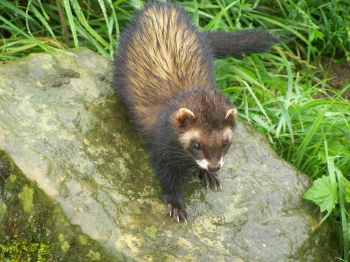Polecat
Polecats (Mustela putorius) – Blackish guard hairs and yellow under fur on the body, giving ‘black and tan’ appearance; banded “bandit” face: pale muzzle, ear tips and ‘eyebrows’, with a broad dark band around the eyes; darker legs and belly, short fluffy tail; is the size of a ferret
Habitat
Urban & gardens, Deciduous woodland, Grassland, Mixed woodland, Arable land
Size
Males 33-45cm, females 32-39cm; tail length: 12-19cm.
Weight
Males weigh around 0.8-1.9kg, females 0.5-1.1kg.
Origin and Distribution
Polecats are found throughout Wales where valleys and farms are favoured, the midlands and parts of central southern England, and are spreading steadily from these areas. There are isolated populations in Cumbria and Caithness, which probably result from unofficial releases. Once, polecats were widespread throughout Great Britain, but were nearly exterminated by 1915. They never occurred in Ireland, or on the outer islands. Although they occur in a wide range of habitats, polecats prefer lowland areas. In England, farmland with hedgerows and small woods is preferred.
General Ecology
Polecat dens are commonly found in rabbit burrows, especially in summer, but they frequently move into farmyards in winter, when they may den in hay bales, under sheds and in rubbish tips. Polecats have territories that vary in size according to habitat and food availability. For males they have been measured at 16-500 ha, and for females about 25-375 ha, using radio-tracking. Territoriality seems weaker in polecats than other mustelids, perhaps because they move around more to exploit seasonally abundant food sources. There are often piles of scats near den sites, but little evidence that scats are left around the territory to defend its borders. Polecats have scent glands either side of the anus, and they produce a pungent, repellent scent.
Diet
In summer, rabbits are a major food, and polecats are slender enough to hunt them within their burrows. In winter, common rats become a favoured food, and sites with good rat populations become usual habitats. Birds may be taken and frogs may be important in spring, when gathered to spawn.
Lifespan
Up to 14 years in captivity, probably five years in the wild.
Breeding
Polecats have one litter a year, with 5-10 young born blind and hairless in late May-early June. They begin to take meat from 3 weeks, and stay with their mothers for 2-3 months. They reach adult size by autumn, and breed at one year old. Pregnancy is direct (no delayed implantation) lasting 40-43 days. Male polecats play no direct part in rearing the young.
Conservation Status
In addition to its protection under the Wildlife and Countryside Act 1981, the polecat has recently (2007) been added to the list of UK BAP mammals, protected as species of principal importance for the conservation of biological diversity in England under Section 74 of the Countryside and Rights of Way (CRoW) Act 2000. Until the 19th Century, polecats were found throughout much of mainland Britain and the Isle of Wight. Habitat fragmentation, persecution by gamekeepers and being killed for their fur drastically reduced this distribution. The polecat population was reduced to about 5,000, but is now more than 46,000. Road accidents are a major threat as they tend to be attracted to other road kill items for food.

 Back
Back
